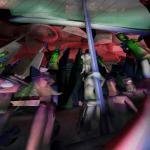Digital art, a definition
Digital art, is nothing much more than a connotation, almost mirror-like, of electronic art.
Quite simply, it indicates the art created on a computer, or that use, non-trivially, the computer to manipulate and edit an forms art piece.
Compared to electronic art, has a slightly narrower meaning, as it tends to indicate projects having an independent life directly inside of the PC.
While the electronic art, by definition, tends to have a more interdisciplinary connotation, going to pull the elements generated on the computer, to other, more traditional media, such as sculpture, theater, ballet, and contribute to the creation of atmospheres formed by hybrid electronic and analogues suggestions.
And that is why I love to call myself an electronic artist.
We talk anyway always about quite subtle meanings, and not universally accepted definitions of something that changes all the time, and that everyone would like to take the credit.
I believe, as expressed elsewhere, that it is always art, and that the difference with the traditional media is only the fact that the 'artist, in this case, looks around, and decides to use the tools it provides him with his time, as always took care of men do not anchored to the archetypes traditionalist.
Surely you can see a liason between these concepts, and artistic movements such as Futurism and other avant-garde ..
Personally, I would avoid to limit access to these types of items, and would extend to the intrinsic nature of 'man, and especially of' artist, who by nature is fascinated by 'unknown, and document what is around him, and always sought to the best tools to express themselves.
Anyway, apart from personal considerations, that since I'm just writing on my blog are more than legitimate, computer art (one of several synonyms of digital art) was born around 1950, with the first experiments of Manfred Frank and Ben Lapsosky , two mathematicians and programmers with an artistic sense, or rather, a contemplative spirit to the beautiful, which, through the 'use of mathematical functions and oscilloscopes, went to create the foundations for graphic projections, going to exploit the variations given by' use of 'oscilloscope combined with the cathode ray tube.
When it comes to digital art, reference is made to a 'multitude of techniques, freely mixed with each of them ..
Let's talk about the most common: The 'generative art: is to create art objects using one or more formulas, or setting certain parameters in a mathematical function.
I am thinking here, for example, to fractals.
The photo manipulation: (or bitmap art) consists in 'developing a' scanned image or digital photos or video, which, suitably treated and manipulated, will create something totally different.
Vector graphics: in this case, the composition is created by artist 'going to use vectors, so infinitely scalable shapes and not related to the resolution of the monitor The 'animation and' processing 3d-like vector graphics, conceptually, use vector 3d to go to form, through a process called rendering, one or more images (ie sequence of images, or animation).
There would be many more forms of expression to speak of, but at the moment I just these, and I remember that can be freely mixed to create new ideas
 Claudio Castelli
Claudio Castelli

